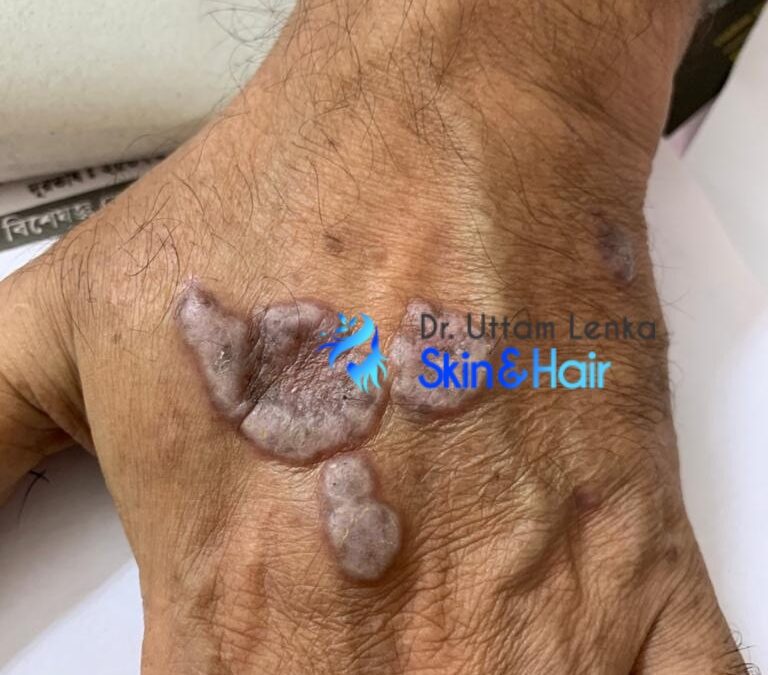It is a type of skin disease in which granular rashes appear in the skin, with violet or purple papules, along with intense itching.
It’s not limited to our skin only, and it may also affect our nails, hair, oral mucosa as well as private parts of our body.
Types of lichen planus :-
- The most common and classical type of lichen planus is that which affects the skin only. It can occur anywhere in the body but usually affects the flexor aspect of the body and the back. Occurrence in the face is uncommon.
- Nail lichen planus – affects the nail, may or may not involve other parts of the body. The skin adjoining the nail grows over the nail bed. Or the nail may split in two.
- Lichen planus hypertrophicus – the affected area of the skin becomes thick. It usually occurs in the leg and the severity of itch is so high that immediate treatment is required.
- Linear lichen planus –the granules of the rash are present in a linear fashion. This is due to Koebner’s phenomenon, which means that the rash tends to spread along the lines of trauma (scratch), which flares up and worsens the condition This phenomenon is also seen is case of Vitiligo, psoriasis etc.
- Oral lichen planus – Occurs in the oral mucosal membrane. It shows white lines in a net like pattern (reticular lichen planus) or ulceration in the oral mucosa (ulcerative lichen planus). The patient usually complains of burning sensation in the mouth and difficulty in eating.
- Bullous lichen planus – It’s a rare case of lichen planus and is charaterized by presence of vesicles or bullae. Usually present in areas affected previously by lichen planus lesions.
- Palmoplantar lichen planus – Usually occurs in the palm of the hand and feet. The skin becomes thick and starts to peel off after intense episodes of itching. It can have symptoms like eczema.
- Lichen planopilaris – usually affects the skin where there is hair. It destroys the hair follicle and then replaces it with scarring, resulting in permanent hair loss. Hence early treatment is required to prevent excessive hair loss.
- Lichen planus pigmentosus – it is not associated with itching, but the skin of the face or the body gradually becomes black, due to hyperpigmentaion, that is, excessive release of melanin pigment. It takes many years, even 5 to 10 years to get cured
EPIDEMIOLOGY – It is equally prevalent in both males and females, and it can occur at any age.
CAUSE
The exact cause of lichen planus is not yet known. However, it is said to be an auto-immune disease, which means that our body’s immune system acts against our own cells, causing inflammation and rashes in the affected area.
Oral lichen planus have been known to be caused after dental filling.
Another cause can be side effect of various medicines, such as :-
- Anti-hypertensive medicines – which are used to reduce our blood pressure, such as Propranolol
- ACE inhibitors and beta blockers
- Antibiotics such as penicillin
- Anti malarial, such as hydroxychloroquine
- Diuretics
- Painkillers etc.
There are many such medicines which can cause rashes. Thus, while visiting a dermatologist, it is recommended to carry your old prescription with you, as your past history of medicine intake can reveal a lot about your condition.
DIAGNOSIS
Usually, lichen planus can be easily diagnosed by clinical examination by a dermatologist, or with the aid of a dermatoscope.
For confirmation, a skin biopsy test can be done, in which a sample of the skin in the affected area is collected and observed under a microscope.
Other skin disease which presents similar symptoms as lichen planus and can be confused with it are :-
- Psoriasis / Guttate psoriasis / Plaque psoriasis
- Pityriasis rosea
- Syphilis
TREATMENT
In case of localized lichen planus lesion, creams and ointments are given for treatment.
Medicines may include :-
- Anti itching / soothing creams
- Steroid creams (to be used as prescribed by the doctor only)
- In case of oral lichen planus, Tacrolimus ointment or any gel based cream may be prescribed.
In case of extensive lesions, that is covering the entire or most of the body, oral medications are prescribed.
- Immunosuppressive medicine, such as steroids, methotrexate, cyclosporine etc.
*steroids are to consumed only after being prescribed, and various tests are done to determine the adequate dosage of steroids that would suit the patient.
- Retinoids
- Anti histamine, such as cetrizine, levocetrizine, fexofenadine, bilastine etc., to reduce itching
PREVENTION
It is advised to not scratch the affected area too much, as this may cause the rash to spread and flare up. (Koebner’s phenomenon)
PROGNOSIS
Lichen planus is a disease, which is highly un predicatable to determine the exact duration to get completely cured.
In most cases, it is seen to be cured in 1 to 2 years. However, many patients have suffered even 5 to 10 years without getting cured. It is frustrating for both the patient as well as the doctor.
COMPLICATION
Post inflammatory hyperpigmentation – after the rashes are treated, the affected area turns black. This can take at least 1 to 1.5 years to get back to normal, maybe more in people with dark skin. Nothing can be done by the doctor, as the pigmentation is located very deep in the skin, the patient can only wait till it’s gone.
Blog by: Dr. Uttam Kumar Lenka, Consultant Dermatologist. Kolkata.



